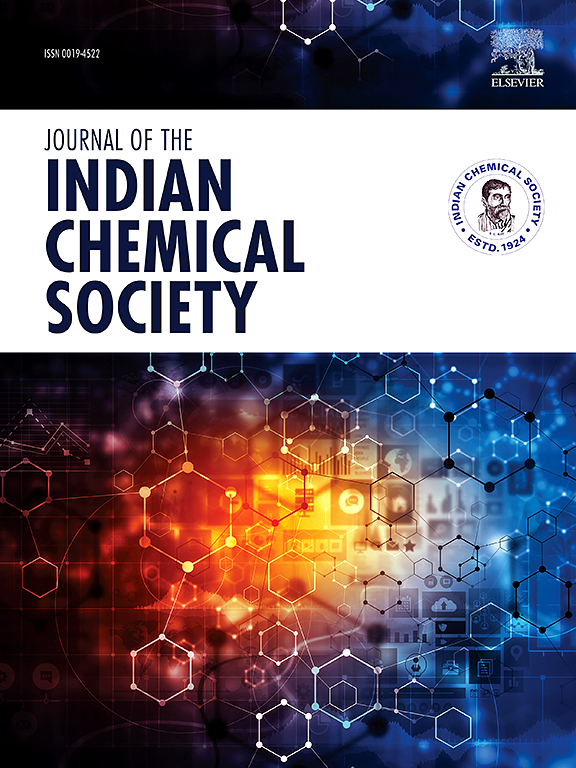金(III)复合纳米颗粒与哌嗪衍生物相互作用的量子化学计算见解-生物传感活性的预测
IF 3.2
4区 化学
Q2 CHEMISTRY, MULTIDISCIPLINARY
引用次数: 0
摘要
本研究考察了1-boc-4-(4-羟基苯基)-哌嗪(1B4HPP)如何与金(III)复合纳米颗粒(AuCl3)相互作用,以确定它们在药物传递和传感目的方面的工作效果。通过吸附过程,金(III)复合纳米颗粒的使用改变了前沿分子轨道(FMO)的能级,最终改善了药物输送系统。理论上的紫外吸收。研究表明,1B4HPP@AuCl3的吸收峰出现在807 nm处,振荡强度为0.008,其中主要的轨道贡献来自于H-3- >;在859 nm处观察到气相和水相的LUMO(66%),振荡强度为0.375,其中主要的轨道贡献来自HOMO- >;Lumo(89%)。在络合物中,气相和水相的分子静电势(MEP)值分别在- 6.039 × 10-2 (a.u) ~ 6.039 × 10-2 (a.u)和- 0.114 (a.u) ~ 0.114 (a.u)之间。对该分子及其配合物进行了非线性光学(NLO)研究,发现配合物的一阶超极化率在气相和水相中分别为2.13 × 10−28 esu和2.28 × 10−28 esu。不同种类的分子间相互作用,包括氢键、范德华力和排斥性空间效应,已经通过非共价相互作用(NCI)调查确定。化合物的生物活性和药物相似特性的研究是该研究的另一个重要组成部分。在未来,预计分子对接技术的应用将对评估与药物传递过程相关的相互作用能至关重要。本文章由计算机程序翻译,如有差异,请以英文原文为准。

Quantum chemical computational insights into interaction of Gold (III) complex nanoparticles with piperazine derivative compound - prediction of biological sensing activities
This study examines how a 1-boc-4-(4-hydroxy-phenyl)-piperazine (1B4HPP) interacts with Gold (III) complex nanoparticles (AuCl3) in order to determine how well they work for drug delivery and sensing purposes. Through adsorption procedures, the usage of Gold (III) complex nanoparticles modifies the energy levels of frontier molecular orbitals (FMO), which eventually improves drug delivery systems. Theoretical UV–vis. studies show that absorption peak of 1B4HPP@AuCl3 is seen at 807 nm with the oscillator strength of 0.008, where major orbital contributions come from H-3- > LUMO (66 %) in gas phase whereas in water phase observed at 859 nm with the oscillator strength of 0.375, where major orbital contributions come from HOMO- > LUMO (89 %). In the complex form the range of molecular electrostatic potential (MEP) values are in the range of −6.039 x 10-2 (a.u.) to 6.039 x 10-2 (a.u.) and – 0.114 (a.u.) to 0.114 (a.u.) in gas and water phase respectively. Non-linear optical (NLO) studies have been carried out on the molecule and its complex, and noticed that first order hyper polarizability value of complex is 2.13 × 10−28 esu in gas phase whereas 2.28 × 10−28 esu in water phases, respectively. Different kinds of intermolecular interactions, including H (hydrogen) bonds, van-der Waals forces, and repulsive steric effects, have been identified through the non-covalent interaction (NCI) inquiry. The investigation of the compound's bioactivity and drug-likeness properties is another important component of the study. In the future, it is expected that the application of molecular docking techniques would be essential for assessing the interaction energies related to drug delivery procedures.
求助全文
通过发布文献求助,成功后即可免费获取论文全文。
去求助
来源期刊
CiteScore
3.50
自引率
7.70%
发文量
492
审稿时长
3-8 weeks
期刊介绍:
The Journal of the Indian Chemical Society publishes original, fundamental, theorical, experimental research work of highest quality in all areas of chemistry, biochemistry, medicinal chemistry, electrochemistry, agrochemistry, chemical engineering and technology, food chemistry, environmental chemistry, etc.

 求助内容:
求助内容: 应助结果提醒方式:
应助结果提醒方式:


